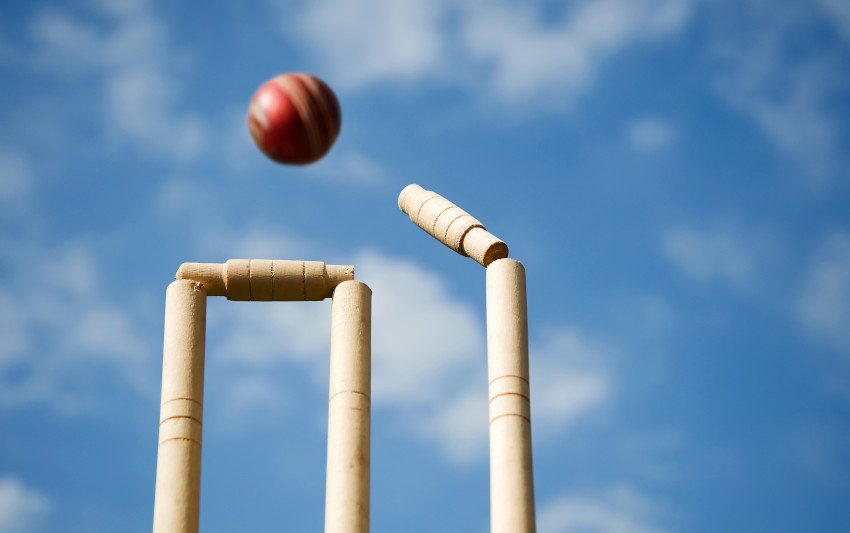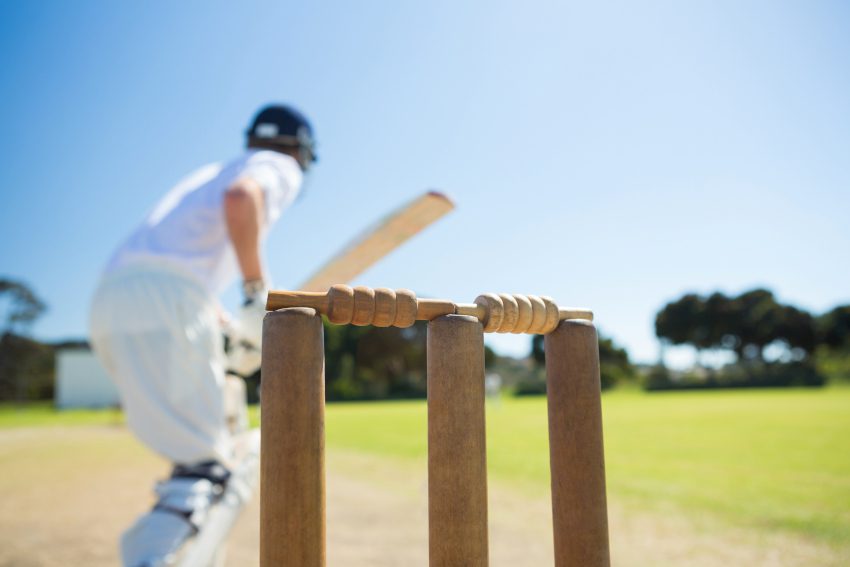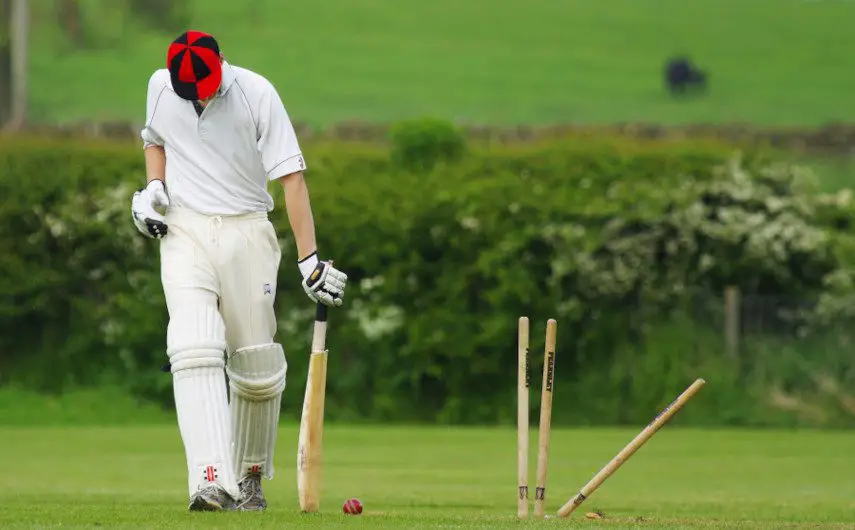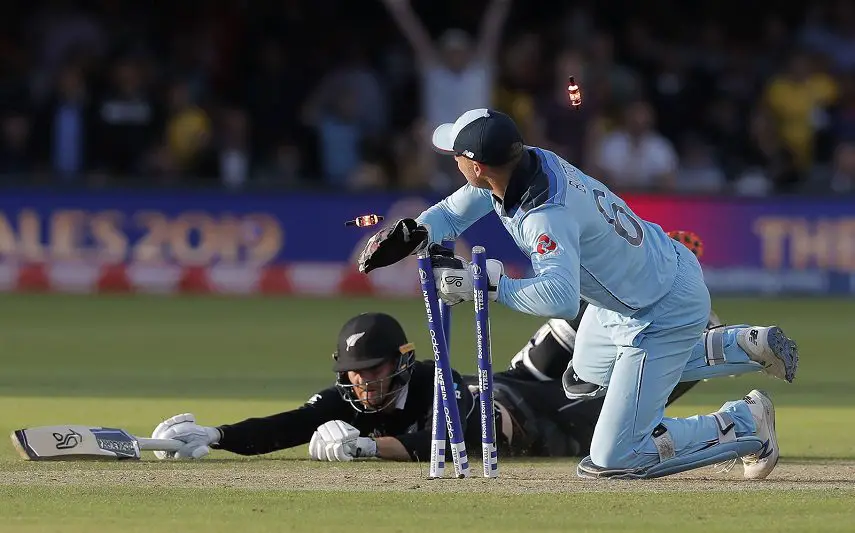Table of Contents
We already know that cricket has a language all of its own and now I’m going to look at a term which could actually be interpreted in different ways.
What Does Stumps Mean in Cricket?
There can be three different answers to this question and the first relates to an essential piece of equipment without which, cricket would not be able to function. The second is less commonly used and relates to a mode of dismissal while the third use of the term ‘stumps’ refers to a specific point in play.
1. Part of the Wicket
The three vertical pieces of wood used at either end of the pitch are known as stumps. Together with the bails, they form part of the wicket. Once put in position, they are referred to separately as the off stump, middle stump and leg stump. The off stump lies on the off side (that is the same side as the batsman’s bat), the middle stump is clearly the stump in the middle, while the remaining leg stump is on the leg side of the striking batsman.
Height and Width of Cricket Stumps
Each stump is long and circular in its design. At the bottom of each stump, the wood has been turned into a spike which inserts into the ground. At the other end is a groove on which the bail rests.
All three stumps must be 28 inches (71.1cms) tall. They are allowed to have a maximum and minimum diameters of one and a half and one and three eighths inches. (3.49 cms and 3.81 cms)

Distance Between Cricket Stumps
The width of each wicket with the three stumps together is set in the laws at nine inches (22.9 cms). As we have seen, the diameter of each stump may vary slightly so the distance between each one will change accordingly.
However, there should be a uniform distance between each stump, keeping in mind that overall width of nine inches. The other important point to check, especially in club cricket, is that the stumps are close enough together so that the ball cannot pass through them.
What are Cricket Stumps Made of?
Traditionally, stumps have always been made of wood. That’s been the material used for hundreds of years since the sport was first developed and modern stumps are still made in this way.
The wood most commonly used is ash. It is durable and should last for many years – certainly for club cricketers. It’s also extremely resilient to the elements so it should be safe to leave those stumps exposed while you’re safely in the pavilion waiting for the rain to clear.
Types of Cricket Stumps
While wooden stumps are still widely used in the club and professional matches, other materials are available. If you’ve watched a lot of T20 games, particularly in the IPL and Big Bash, you may see the bails light up when they are disturbed.
These are ‘zing’ bails and they are best used in conjunction with stumps that are made from composite plastic. This type of led stumps was approved back in 2013 by the ICC and it has been in widespread use ever since.
In practice situations, you may also see a type of ‘springback’ wicket being used. This is especially convenient for net batting and general training and it will help to keep the session moving.
The stumps form part of one unit so, when they are struck by the ball, they will literally spring back into position as opposed to falling to the ground. This means that batsmen and coaches spend less time picking up the stumps although they can be used with bails which are optional.
In other forms of training including junior level games such as Kwik Cricket, plastic stumps may be used. They are also likely to be produced in one solid block which means that they are convenient and can be set up in a short space of time.
In junior cricket, tennis balls or plastic balls can be used so the plastic stumps will be ideal for this type of situation.

2. A Mode of Dismissal
The word ‘stumps’ could also be used as reference to a specific mode of dismissal. Strictly speaking, the dismissal in question is known under the laws as ‘stumped’ and it happens when the wicket keeper removes the bails when the striking batsman is out of their ground.
However, you may hear this being colloquially referred to as ‘stumps’. It’s a much rarer use of the word but it will appear occasionally so this must be included on the list.
Other dismissals that require the stumps to be disturbed are ‘bowled’ and ‘run out’. It’s unlikely that the word ‘stumps’ will be used directly here but it’s worth keeping in mind just what an important role stumps play in the game of cricket.
3. End of Day’s Play
The term ‘stumps’ will also be used to signify the end of a day’s play. This will only tend to happen in test matches and first class cricket games which are played over multiple days.
When the final ball is delivered, the umpires called stumps. The bails and the stumps themselves will then be removed.
Note that the actions taken by the umpires at the end of the day will be different to those that take place ahead of the lunch and tea intervals. On these occasions, only the bails will be removed and the standing umpire will call ‘lunch’ or ‘tea’ as applicable.
If you look at scorecards while a match is in progress, they will also refer to ‘stumps’ when the day is over. As a reference to the end of a day’s play, this is the third time when you will hear the word ‘stumps’ being used.


